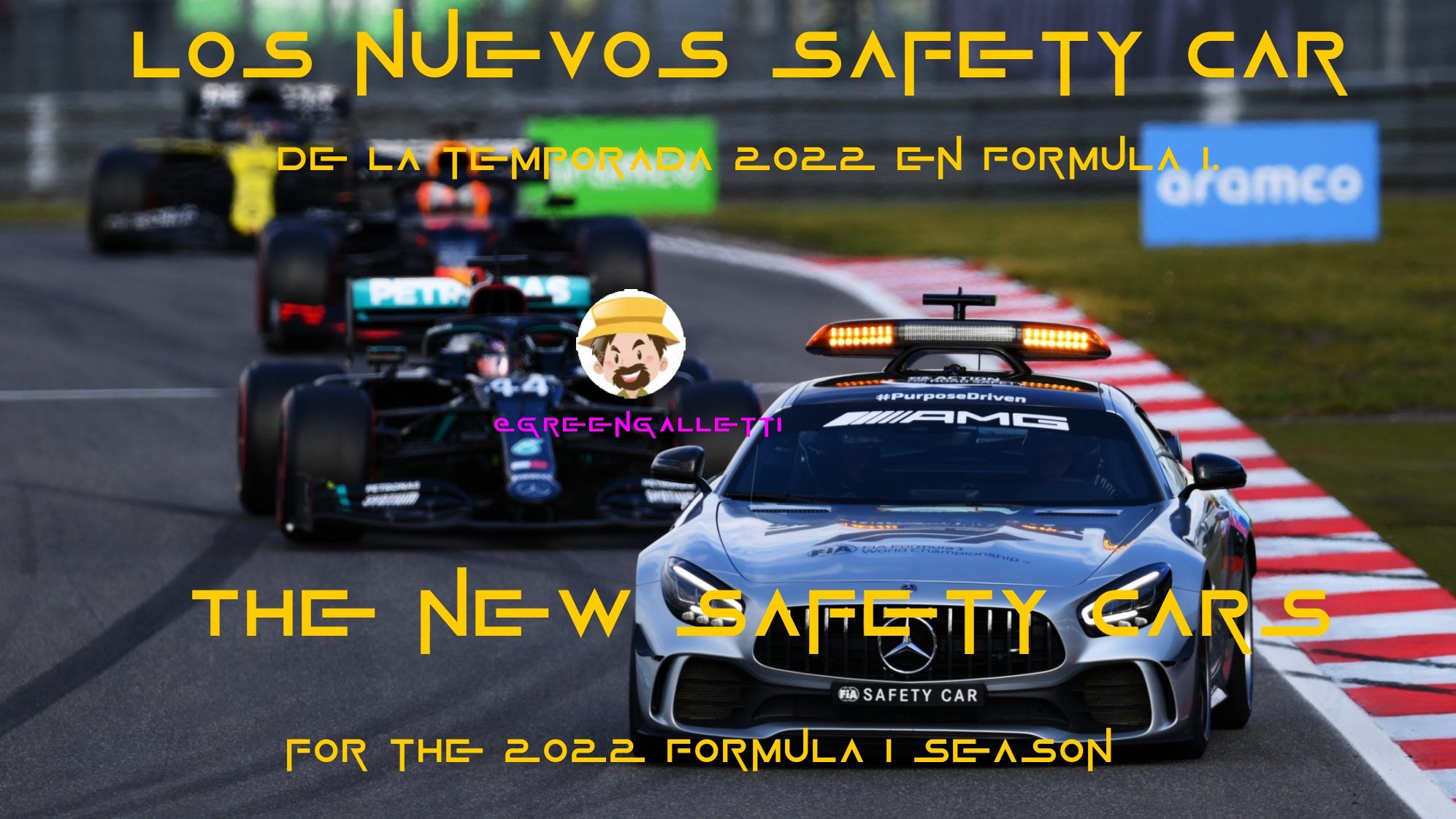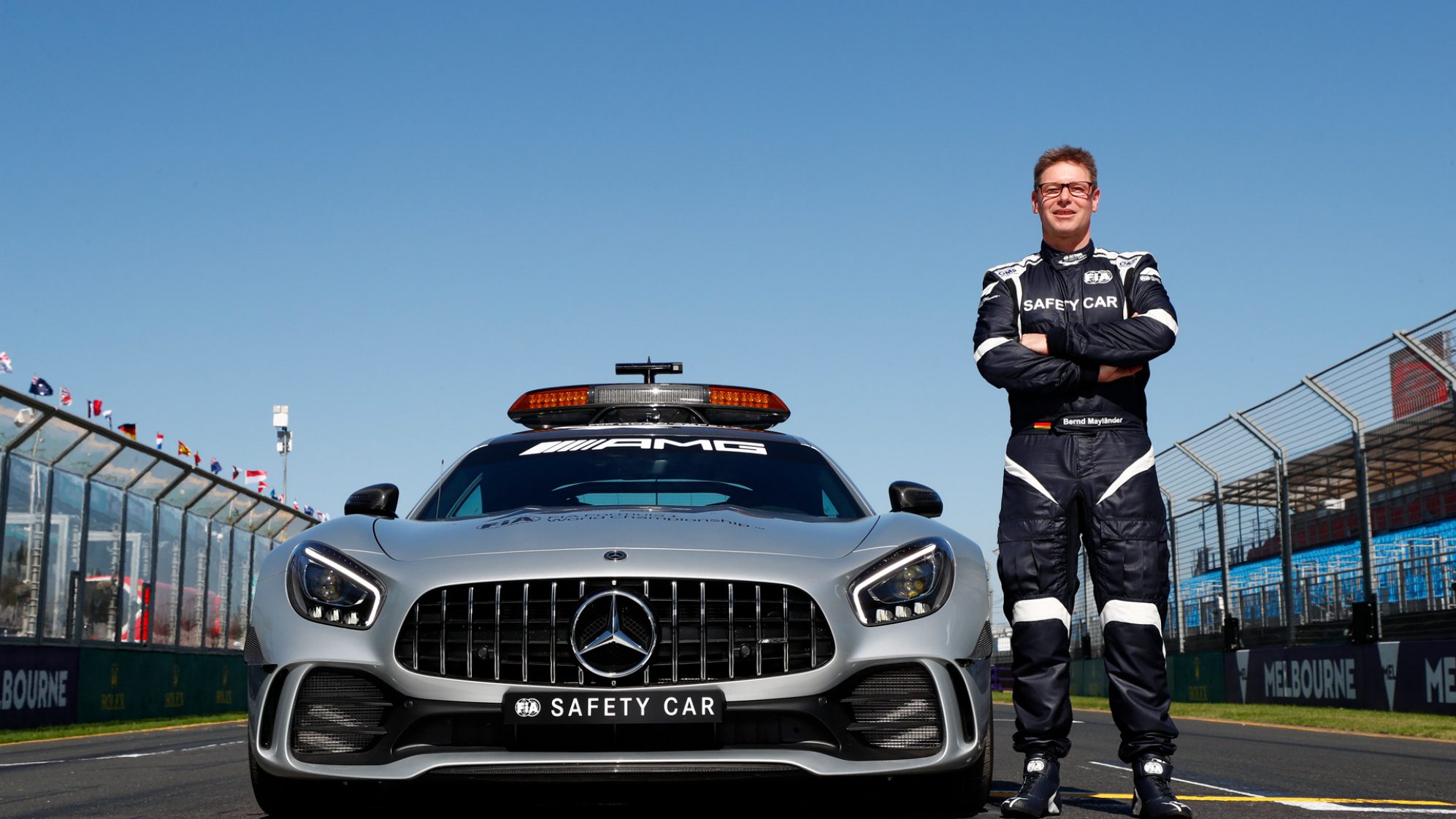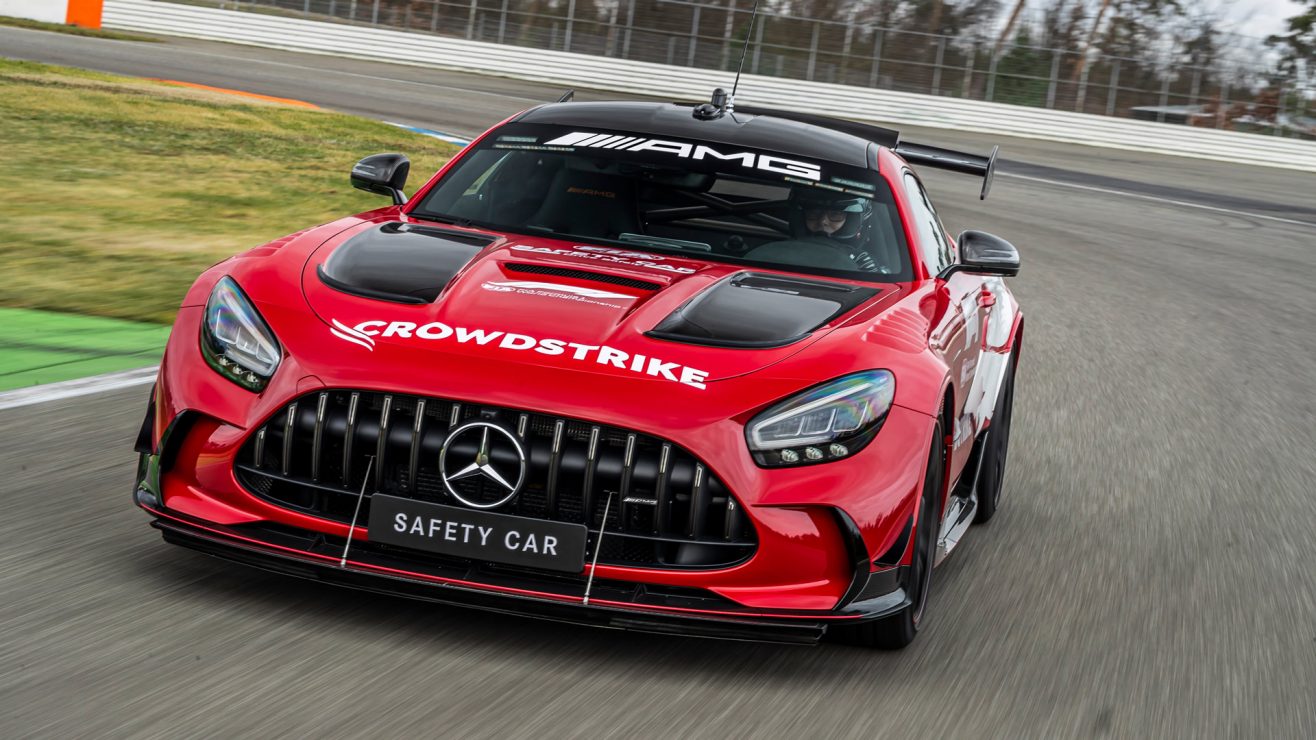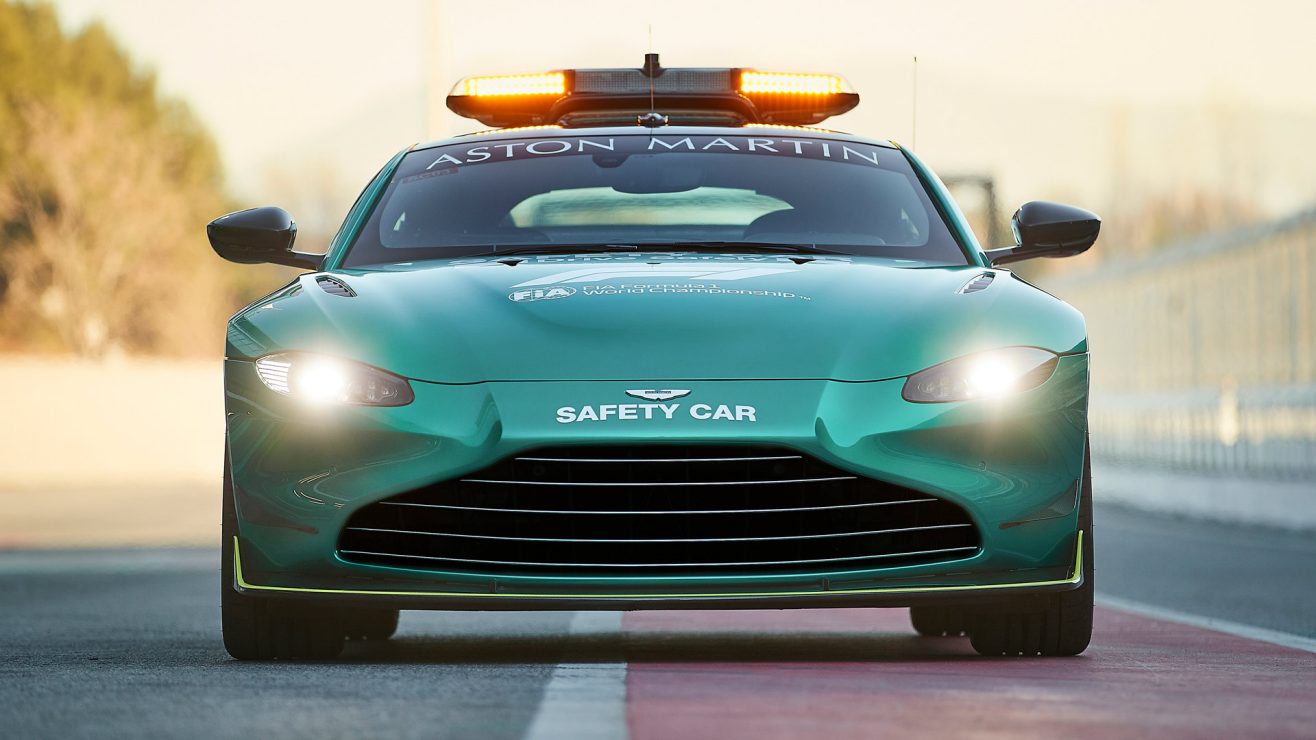[ESP/ENG] Los nuevos Safety Car de la temporada 2022 en Fórmula 1. / The new Safety Cars for the 2022 Formula 1 season.

Qué sabemos en realidad del coche de seguridad de la Fórmula 1, el tan famoso "safety car", una palabra que se ha impuesto en todos los aficcionados a los deportes motores?
Mucho y poco a decir la verdad como todos los términos que comienzan a navegar sobre la onda de los comentarios y medios de comunicación deportivos, en este paso, pero sobre los cuáles no se termina nunca de ahondar lo suficiente.
Sabemos por ejemplo que entran en determinadas circunstancias que pueden poner en peligro la incolumnidad de los participantes en una carrera, ya que sea por accidentes, por monoplazos que se detienen en aspectos no seguros de los circuitos, por condiciones meteorológicas no seguras, etc.
Se encolumnan delante del pelotón de autos y giran todas las vueltas necesarias a liberar el peligro por parte de los adeptos a la seguridad y control de la pista.
A partir de ese momento apagan las luces que en ese tiempo se han mantenido siempre encendidas anunciando que en la próxima vuelta se retiran de la pista y la carrera puede reiniciar normalmente su desarrollo.
A partir del 2015 la FIA introduce el concepto de Safety Car virtual que, tal como lo prescribe el reglamento FIA, se deberá utilizar "cuando sean necesarias las dobles banderas amarillas y pilotos o comisarios puedan estar en peligro y no sea necesario sacar el coche de seguridad tradicional" -artículo 41 del reglamento-, es decir en situaciones de seguridad no extrema, período durante el cuál los pilotos no deben exceder una cierta velocidad si no quieren ser sancionados.
El sistema de la safety car virtual se hizo efectivo como alternativa de seguridad tras el grave accidente sufrido por Jules Bianchi en el Gran Premio de Japón el 5 de octubre de 2014 donde recordemos, el piloto francés sufrió un desafortunado accidente al chocar con una grúa que asistía al monoplazo pilotado por Adrian Sutil que había quedado fuera de carrera en el exterior de la curva 7, fuera de la pista, pero que podía representar un eventual peligro para otros autos que se despistaran en ese mismo lugar. Nueve meses más tarde falleció en el hospital de Niza sin haberse nunca recobrado. La FIA, en homenaje, retiró el número 17 de los autos.

What do we really know about the Formula 1 safety car, the so famous "safety car", a word that has imposed itself on all motorsports fans?
Much and little to tell the truth as all the terms that begin to sail on the wave of the commentaries and sports media, in this step, but on which it is never finished to deepen enough.
We know for example that they enter in certain circumstances that can put in danger the incolumnidad of the participants in a race, either by accidents, by single-seaters that stop in not sure aspects of the circuits, by not sure meteorological conditions, etc.
They line up in front of the pack of cars and turn as many laps as necessary to release the danger on the part of the followers of safety and control of the track.
From that moment on, they turn off the lights that have been always on during that time, announcing that in the next lap they will leave the track and the race can restart normally.
From 2015 the FIA introduces the concept of virtual safety car which, as prescribed by the FIA regulations, must be used "when double yellow flags are necessary and drivers or marshals may be in danger and it is not necessary to bring out the traditional safety car" -article 41 of the regulations-, i.e. in non-extreme safety situations, a period during which drivers must not exceed a certain speed if they do not want to be penalized.
virtual safety car system became effective as a safety alternative after the serious accident suffered by Jules Bianchi at the Japanese Grand Prix on October 5, 2014 where let's remember, the French driver suffered an unfortunate accident when he collided with a crane that was assisting the single-seater driven by Adrian Sutil that had been out of the race on the outside of Turn 7, off the track, but could represent an eventual danger for other cars that would stray in that same place. Nine months later, he died in hospital in Nice without ever having recovered. The FIA, in tribute, removed the number 17 from the cars.
Bernd Mayländer, el hombre de la safety car. / Bernd Mayländer the safety car man.
En forma ininterrumpida desde el año 2000 (a excepción del Gran Premio de Canadá de 2001 donde fue reemplazado por su compañero Marcel Fässler a consecuencia de un accidente) Bernd Mayländer ha sido el "piloto oficial" de la safety car.
Hasta el año 2000 participó activamente en la Fórmula Ford, la Copa Porsche Carrera, y en el Deutsche Tourenwagen Meisterschaft originario e incluso ganó las 24 Horas de Nürburgring a bordo de un Porsche 911 GT3.
En una entrevista concedida recientemente admite que el piloto más complicado para tener detrás del auto es Hamilton porque está continuamente acelerando, frenando, zigzagueando, a veces aproximándose demasiado al auto de seguridad lo que le hace perder la visual desde los espejos retrovisores.
Otro piloto similar a Hamilton según Maylander es Vettel, mientras que Schumacher y Rosberg eran más tranquilos y Verstappen se asemeja más a estos dos últimos que a los dos primeros.

Since 2000 (with the exception of the 2001 Canadian Grand Prix where he was replaced by his teammate Marcel Fässler due to an accident) Bernd Mayländer has been the "official driver" of the safety car.
Until 2000 he was active in Formula Ford, the Porsche Carrera Cup, and the original Deutsche Tourenwagen Meisterschaft and even won the 24 Hours of Nürburgring in a Porsche 911 GT3.
In a recent interview he admits that the most complicated driver to have behind the car is Hamilton because he is continuously accelerating, braking, zigzagging, sometimes getting too close to the safety car, which makes him lose the view from the rear-view mirrors.
Another driver similar to Hamilton according to Maylander is Vettel, while Schumacher and Rosberg were calmer and Verstappen is more similar to the latter two than to the first two.
Los autos de la safety car para la temporada 2022. / Safety car cars for the 2022 season.

A inicios del año y pocos días antes de comenzar las presentar oficiales de cada equipo con vistas a la nueva temporada Mercedes y Aston Martin presentaron los vehículos destinados a prestar servicio como Safety Car para la temporada 2022 del Campeonato del Mundo de Fórmula 1.
Ambos recurrieron al sector especializado en carreras de Fórmula 1 para diseñay y presentar sus autos de seguridad: Mercedes los hizo con la división AMG mientras que Aston Martin ( que no quiso cambiar su modelo del año pasado y seguirá presentando a tal fin el coupé Vantage) lo hizo con su división Racing.
Para diferenciarlo de los modelos usados en los dos años anteriores Aston Martin ha cambiado la decoración externa pero cierto prevaleciendo el color verde "british" característico de muchos automóviles del Reino Unido.
Mercedes, en cambio, propuso un cambio más radical -como en el monoplaza de la Fórmula 1- también coupè de estilo deportivo, el Mercedes AMG GT Black Series, que tiene una particularidad para los fans de la marca que llama la atención y donde se nota una clara intención de promover el marketing del auto: tiene las mismas especificaciones técnicas del modelo que se produce en serie.
Contrastando con el verde de Aston Martín esta vez los Mercedes Safety Car no tendrán el color plateado de los monoplazas sino un rojo estandard que, además, lucirán el logo del patrocinador.
Tal como sucedió durante la temporada anterior, ambos proveedores se alternarán en as funciones de auto de seguridad. Cada uno lo hará en 11 once carreras de acuerdo al cronograma oficial de la FIA al dìa de la fecha.
Así como se esperaron con ansias las nuevas normas reglamentarias sobre el aspecto aerodinámico de los monoplazas para el 2022, no despiertan menor interés los cambios que están por llegar a la Safety Car con el fin de enmendar las distorsiones que, a causa de interpretaciones personalizadas de las autoridades de pista, hicieron que en la última carrera de 2021, en Abu Dhabi, el británico Lewis Hamilton perdiera en la última vuelta el título frente al holandés Max Verstappen.
Esta situación dio lugar a la creación de una nueva Comisión de Arbitraje y de Dirección de Carreras que debería en breve término dictar una serie de normativas específicas al respecto para impedir que se tomen decisiones deportivas unilaterales y no ajustadas al reglamento de la FIA.

At the beginning of the year and a few days before the start of the official presentations of each team for the new season, Mercedes and Aston Martin presented the vehicles destined to serve as Safety Car for the 2022 Formula 1 World Championship season.
Both resorted to the specialized Formula 1 racing sector to design and present their safety cars: Mercedes did it with the AMG division while Aston Martin (which did not want to change its model from last year and will continue to present the Vantage coupe for this purpose) did it with its Racing division.
To differentiate it from the models used in the previous two years, Aston Martin has changed the external decoration, but the "British" green color, characteristic of many cars from the United Kingdom, will prevail.
Mercedes, on the other hand, proposed a more radical change - as in the Formula 1 single-seater - also a sports coupe, the Mercedes AMG GT Black Series, which has a particularity for fans of the brand that attracts attention and where a clear intention to promote the marketing of the car is noted: it has the same technical specifications of the model that is produced in series.
In contrast to Aston Martin's green, this time the Mercedes Safety Car will not have the silver color of the single-seaters, but a standard red, which will also bear the sponsor's logo.
Another novelty of this year's Safety Cars is that the emergency cars proposed by Mercedes AMG replace the traditional light bar mounted on the roof - the classic horizontal beacons - with a lighting system installed on the windshield and rear wing and completing the choreographed show we could say - if we were in the theater - the side windows can light up in colors to let the spectators know when they are called back to the pit.
To keep in tune with technology the new Mercedes AMG GT Black Series will have two monitors with wireless internet connection, with the aim of providing assistance to the co-driver who this year will be Richard Darker. and also as info to show in real time everything that happens on the track.
The Aston Martin Vantage offers the same technological alternatives as its competitor but keeps the traditional light bar on the roof of the car.
Bernd Maylander will be the official driver in charge of driving the Safety Car, regardless of whether it is a Mercedes AMG or an Aston Martin.
As was the case during the previous season, both suppliers will alternate in the role of safety car. Each will do so in 11 eleven races according to the official FIA schedule as of today.
Just as the new regulations on the aerodynamic aspect of single-seaters for 2022 have been eagerly awaited, no less interest is aroused by the changes that are about to be made to the Safety Car in order to correct the distortions that, due to personalized interpretations by the track authorities, caused the British driver Lewis Hamilton to lose the title to the Dutchman Max Verstappen on the last lap at the last race in Abu Dhabi in 2021.
This situation led to the creation of a new Commission of Arbitration and Race Direction that should soon issue a series of specific regulations in this regard to prevent unilateral sporting decisions not in line with the FIA regulations.


La parte inferior del banner de la firma corresponde al badget elaborado por el equipo de @hivebuzz. Mi agradecimiento a ellos y en particular a @arcange.
The lower part of the signature banner corresponds to the badget made by the @hivebuzz team. My thanks to them and in particular to @arcange.
El banner titulado Reseñas Deportivas / Sports Reviews personalizado por el autor es propiedad de PNGWing.
The banner titled Reseñas Deportivas / Sports Reviews customized by the author is property of PNGWing.
Traducido con / Translated with: DeepL Translator.










Comments